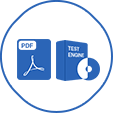Last Update 20 hours ago Total Questions : 100
The Oracle Cloud Infrastructure 2025 Developer Professional content is now fully updated, with all current exam questions added 20 hours ago. Deciding to include 1z0-1084-25 practice exam questions in your study plan goes far beyond basic test preparation.
You'll find that our 1z0-1084-25 exam questions frequently feature detailed scenarios and practical problem-solving exercises that directly mirror industry challenges. Engaging with these 1z0-1084-25 sample sets allows you to effectively manage your time and pace yourself, giving you the ability to finish any Oracle Cloud Infrastructure 2025 Developer Professional practice test comfortably within the allotted time.
Which technique is used for testing the entire user flow as well as the moving parts of a cloud native app, ensuring that there are no high-level discrepancies?
You have just finished building and compiling the software required to implement the API microservice component. You need to rebuild the API docker image, and plan to tag it as: ocIdevops/api:latest Which docker command would re-create the API docker image?
Kubernetes includes various elements such as compute, network, and storage. Compute is essentially CPU (units) and memory (bytes). Within an OKE cluster, what is considered to be the smallest unit of deployment with respect to compute?
Which concept in OCI Queue is responsible for hiding a message from other consumers for a predefined amount of time after it has been delivered to a consumer?
Which feature is typically NOT associated with Cloud Native?
Which is ONE of the differences between a microservice and a serverless function?
Which of the following is NOT a criterion that is usually met by a microservice?

